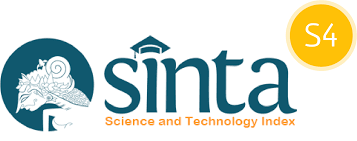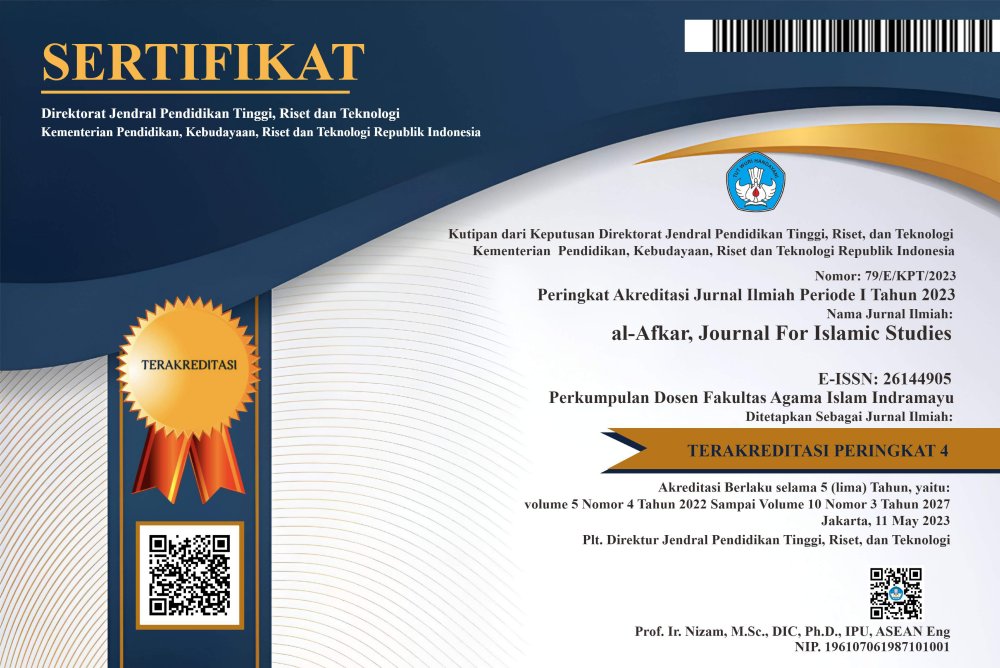The Role Of Islamic Religious Education Teacher In Overcoming Youth Determination At Rembang State Vocational School
DOI:
https://doi.org/10.31943/afkarjournal.v6i3.640Keywords:
Role, PAI Teachers, Youth DeterminationAbstract
Juvenile delinquency is a serious problem, because if it is done repeatedly, it will eventually have a fatal impact and harm oneself and even others. Because of these problems, it raises questions about the role and contribution of Islamic religious education teachers in dealing with juvenile delinquency that occurs in schools. This type of research is a case study with a descriptive qualitative approach. Data collection techniques using interviews, observation, and documentation. The data analysis technique is according to Milles and Huberman's opinion with three stages, namely data reduction, data display, then conclusion. In overcoming juvenile delinquency, PAI teachers have a role. First, PAI teachers provide good motivation and role models and position themselves as parents. Second , PAI teachers provide guidance on good religious and moral values, and provide approaches so that students can share about the problems they face. Third, PAI teachers teach Islamic religious values. Fourth, PAI teachers master science, train and familiarize students with applying Islamic values which are manifested in daily behavior.
Downloads
References
Achakanalli, V. C., & Kumbhar, S. I. (2018). Socio-Economic Factors Responsible for Increasing Juvenile Delinquency and Various Rehabilitative Measures of Government. Scholarly Research Journal for Humanity Science & English Language, 6(1960). www.srjis.com
Acharya, S., & Delhi, N. (2015). The Study of Juvenile Delinquency With Reference to Psychological Perspectives in The Juvenile Homes of Delhi. International Journal of Advanced Research in Management and Social Sciences, 6(11), 13–27.
Al-Zoby, K. F., & Al-Qudah, M. A. (2020). Promoting Positive Behaviors Among the Lower Primary School Students. Journal of Education and Practice, April. https://doi.org/10.7176/jep/11-8-12
Alamri, W. A. (2019). Effectiveness of Qualitative Research Methods: Interviews and Diaries. International Journal of English and Cultural Studies, 2(1), 65. https://doi.org/10.11114/ijecs.v2i1.4302
Badasa, G. G., Gemeda, A., Gaduda, B. E., & Wondimu, B. (2019). Juvenile Delinquency: A Need to Multiple Explanations and Interventions. OALib, 06(12), 1–10. https://doi.org/10.4236/oalib.1105904
Baxter, P., & Jack, S. (2015). Qualitative Case Study Methodology: Study Design and Implementation for Novice Researchers. The Qualitative Report, January. https://doi.org/10.46743/2160-3715/2008.1573
Bowen, G. A. (2009). Document analysis as a qualitative research method. Qualitative Research Journal, 9(2), 27–40. https://doi.org/10.3316/QRJ0902027
Ekka, P. M. (2021). A review of observation method in data collection process. IJRTI International Journal for Research Trends and Innovation, 6(12), 17–19.
Esiri, M. O., & Ejechi, E. (2021). Juvenile delinquency dimension of child labour: implications for human and capital development in Nigeria. International Journal of Social Sciences, 4(1), 69–77. https://doi.org/10.31295/ijss.v4n1.1351
Ferdoos, A., & Ashiq, A. (2015). Impact of Urbanization on Juvenile Delinquency: a Study of Muzaffarbad Jail. International Journal of Criminology and Sociological Theory, 8(1), 1–14. https://ijcst.journals.yorku.ca/index.php/ijcst/article/view/40241
Henry, S., Henaghan, M., Sanders, J., & Munford, R. (2015). Engaging Youth in Youth Justice Interventions: Well-being and Accountability. Youth Justice, 15(3), 240–255. https://doi.org/10.1177/1473225414562636
Hobson, J., Twyman-Ghoshal, A., Banwell-Moore, R., & Ash, D. P. (2022). Restorative Justice, Youth Violence, and Policing: A Review of the Evidence. Laws, 11(4), 1–20. https://doi.org/10.3390/laws11040062
Hoeve, M., Jak, S., Stams, G. J. J. M., & Meeus, W. H. J. (2016). Financial Problems and Delinquency in Adolescents and Young Adults: A 6-Year Three-Wave Study. Crime and Delinquency, 62(11), 1488–1509. https://doi.org/10.1177/0011128714541190
Ibrahim, R. B., Nasirudeen, I. A., & Isiaka, M. (2020). Juvenile Delinquency: The Role of Bystanders and Enablers. International Journal of Scientific and Research Publications (IJSRP), 10(06), 857–865. https://doi.org/10.29322/ijsrp.10.06.2020.p102101
Jamir Singh, P. S., & Azman, A. (2020). Dealing with Juvenile Delinquency: Integrated Social Work Approach. Asian Social Work Journal, 5(2), 32–43. https://doi.org/10.47405/aswj.v5i2.139
Johan, R., & Harlan, J. (2014). Education Nowadays. International Journal of Educational, 4(5), 6.
Manoj, G. (2019). Juvenile Delinquency : An Interplay of Incentives Journal of Academic Research in Economics. Journal of Academic Research in Economics, December 2018.
Miles, M. B., Huberman, A. M., & Saldana, J. (2014). Qualitative Data Analysis. In L. Barrett (Ed.), SAGE Publication, Inc. (Third). SAGEPublications, Inc.
Mocan, H. N., & Rees, D. I. (2005). Economic conditions, deterrence and juvenile crime: Evidence from micro data. American Law and Economics Review, 7(2), 319–349. https://doi.org/10.1093/aler/ahi011
Morgan, H. (2022). Conducting a Qualitative Document Analysis. Qualitative Report, 27(1), 64–77. https://doi.org/10.46743/2160-3715/2022.5044
Morgan, S. J., Pullon, S. R. H., MacDonald, L. M., McKinlay, E. M., & Gray, B. V. (2017). Case study observational research: A framework for conducting case study research where observation data are the focus. Qualitative Health Research, 27(7), 1060–1068. https://doi.org/10.1177/1049732316649160
Muzamil, M., Shah, G. H., & James, K. (2021). Impact of Teachers’ Classroom Manners, Teaching Strategies, And Parents’ Socioeconomic Status on Students’ Performance. International Journal of Social Sciences & Educational Studies, 8(1). https://doi.org/10.23918/ijsses.v8i1p91
Ndayambaje, E., Umwari, Y., & Yulia, A. (2020). The Impact of Family Conflicts on Children Education. International Journal of Pedagogy and Teacher Education, 4(2), 105. https://doi.org/10.20961/ijpte.v4i2.43123
Ningsih, D. A. P. A. (2016). Developing students’ positive behaviour through the implementation of positive reinforcement in efl class. Journal of English Language Learning, 5(1), 23–32.
Ramos, M. C., Guerin, D. W., Gottfried, A. W., Bathurst, K., & Oliver, P. H. (2005). Family conflict and children’s behavior problems: The moderating role of child temperament. Structural Equation Modeling, 12(2), 278–298. https://doi.org/10.1207/s15328007sem1202_6
Rashidi, M. N., Ara Begum, R., Mokhtar, M., & Pereira, J. J. (2014). The Conduct of Structured Interviews as Research Implementation Method. Journal of Advanced Research Design ISSN, 1(1), 28–34.
Rathi, T., & Ronald, B. (2022). Questionnaire as a Tool of Data Collection in Empirical Research. Journal of Positive School Psychology, 2022(5), 7697–7699. http://journalppw.com
Raturi, S., & Rastogi, S. (2022). Juvenile delinquency and legal aspects. International Journal of Health Sciences, 6(April), 12297–12304. https://doi.org/10.53730/ijhs.v6ns1.8076
Ravulo, J. (2019). The role of holistic approaches in reducing the rate of recidivism for young offenders. The Judicial Review, 14(2), 125–145.
Reeta, V., & Singh, G. (2020). Broken Families and Impact on Juvenile Delinquency. InternationalJournalofHumanitiesandSocialScienceInvention (IJHSSI), 9(5), 33–38.
Rodríguez, F. J., Rodríguez-Franco, L., López-Cepero, J., & Bringas, C. (2010). Juvenile delinquency and young offender: Bibliographical and bibliometric review of two perspectives of study. European Journal of Psychology Applied to Legal Context, 2(2), 117–143.
Ryan, F., Coughlan, M., & Cronin, P. (2009). Interviewing in qualitative research: The one-to-one interview. International Journal of Therapy and Rehabilitation, 16(6), 309–314. https://doi.org/10.12968/ijtr.2009.16.6.42433
Suwandi, L. J. (2019). the Implementation of Positive Behavior Support Through Champs To Improve Student Behavior. Satya Widya, 35(2), 112–125. https://doi.org/10.24246/j.sw.2019.v35.i2.p112-125
Suyati, E. S., Sonedi, Bulkani, Fatchurahman, M., Nurbudiyani, I., & Setiawan, M. A. (2022). The relationship of physical fitness and social-economic status and students’ learning achievement La relación de la frescura física y el estatus socioeconómico y el logro de aprendizaje de los estudiantes. Retos, 46, 467–479.
Teegavarapu, S., Summers, J. D., & Mocko, G. M. (2008). Case study method for design research: A justification. Proceedings of the ASME Design Engineering Technical Conference, 4(January), 495–503. https://doi.org/10.1115/DETC2008-49980
Turnbull, D., Chugh, R., & Luck, J. (2021). The Use of Case Study Design in Learning Management System Research: A Label of Convenience? International Journal of Qualitative Methods, 20, 1–11. https://doi.org/10.1177/16094069211004148
Zevalkink, J. (2021). Observation method. Mentalizing in Child Therapy, May, 100–113. https://doi.org/10.4324/9781003167242-6
Zuhdi, A., Firman, F., & Ahmad, R. (2021). The importance of education for humans. SCHOULID: Indonesian Journal of School Counseling, 6(1), 22. https://doi.org/10.23916/08742011
Downloads
Published
How to Cite
Issue
Section
License
Copyright (c) 2023 Abdul Khakim, Mochamad Fajrin, Mohammad Ghofar Abdul Ghany, Riza Ayu Dewi Jayanti, Lestari Budianto

This work is licensed under a Creative Commons Attribution 4.0 International License.



















